A Guide to Enchanting Hummingbird Plants in Illinois
In the realm of flora that beckon hummingbirds, a world of endless possibilities unfolds. However, the key lies in discovering the resilient plants that can flourish and thrive amidst the unpredictable tapestry of weather conditions. Remember, a scorching or frigid climate can leave these delicate plants withering away, unable to provide the alluring nectar that our beloved hummingbirds seek.
To navigate the intricate dance of nature, we turn to the United States Department of Agriculture (USDA) plant hardiness zone map, meticulously divided into 13 zones based on average minimum temperatures. Each state further harbors a multitude of unique zones. Plants, ever adaptive, flourish in distinct zones, with the ability to endure minimal temperatures, but ultimately succumbing if confronted with a chilling environment.
Illinois, with its divergent climates, showcases the impact of geographical variance on the survival of hummingbird plants. The northern region finds itself nestled within Hardiness Zone 5, while the southern reaches embrace Zone 6, with the exception of the far south, where Zone 7 takes root.
It is vital to acknowledge that scorching temperatures can also present challenges for certain plants. In response to this concern, the American Horticultural Society has unveiled the plant heat-zone map, revealing the average number of days a specific area experiences temperatures exceeding 86 degrees Fahrenheit.
Illinois, encompassing heat zones 4 to 7, basks in a higher frequency of warm days in the south compared to its northern counterparts. However, it is the harsh grasp of winter that predominantly influences the selection of hummingbird plants suitable for cultivation in the region.
Rest assured, as we unveil a collection of exquisite nectar-rich flowers, painstakingly assessed against Illinois’ cold and heat zones. These extraordinary plants not only boast irresistible allure for hummingbirds but are also poised to thrive within the whims of Illinois’ ever-changing climate.
Yet, heed the cautionary whisper: plants listed for cold zones 6 to 7 may struggle to survive the colder winters of Zone 5 without proper protection. Exercise due diligence when cultivating these delicate darlings, ensuring their tender roots remain shielded from the unforgiving frost.
Thus, sow these blossoms far and wide, inviting a captivating flurry of hummingbirds to grace the enchanting landscapes of Illinois.
1. Nasturtiums
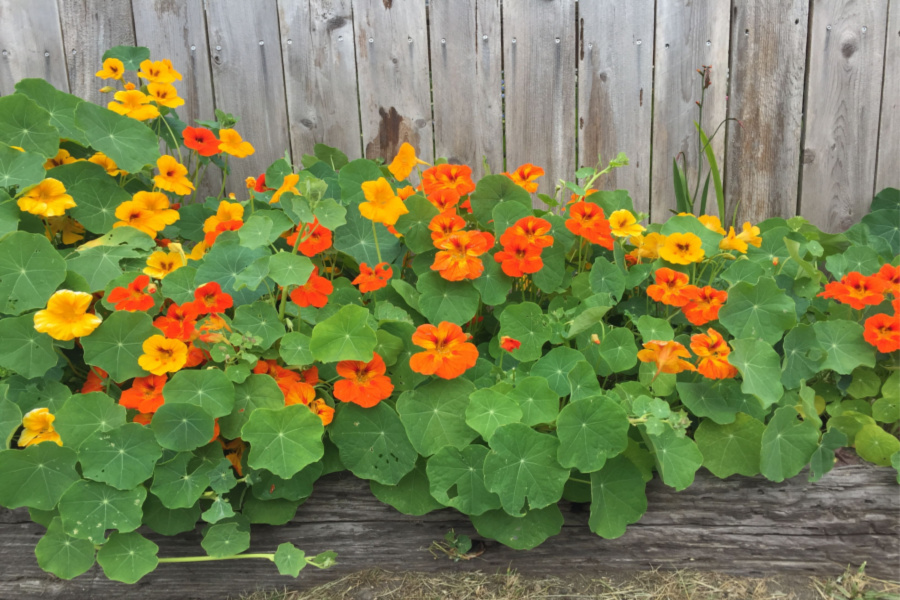
Envision cascades of trailing edible flowers adorning hanging baskets, designed to entice hummingbirds with their nectar-rich depths. Nasturtiums, available in both trailing and bush varieties, make splendid annual additions to your garden. Plant their seeds shortly after the last frost, ensuring they are adequately watered during the growth season and pruned through deadheading.
– Common Name: Nasturtiums
– Scientific Name: Tropaeolum
– Growing Zones: 2 – 11
– Sun: Full
– Soil: Well-drained
– Colors: Red, orange, yellow, pink
– Height: 1 – 10 feet
– Spread: 1 – 3 feet
– Plant Type: Annual
2. Zinnia
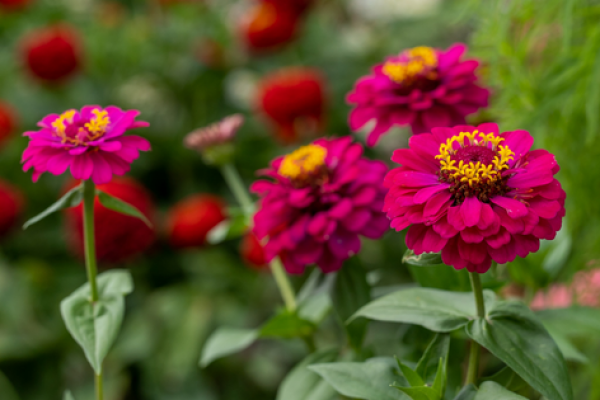
Delighting in the captivating splendor of zinnias, we venture into the realm of flowering shrubs, native to the scrublands and dry grasslands of North America. Within this genus, we uncover three distinct types based on their petals: single-flowered, double-flowered, and semi-double-flowered. The Zinnia elegans reigns supreme, captivating hearts with its towering stems and resplendent colors. These magnificent blossoms, spanning the spectrum from white to purple, evoke enchantment in your backyard, beckoning pollinators like butterflies and hummingbirds.
Growing zinnias demands direct planting, as these delicate beings prefer to remain undisturbed. Once nestled under the warmth of the sun and graced by well-drained soil, these vibrant blooms will bless your garden with their ephemeral radiance.
– Common Name: Zinnia
– Scientific Name: Zinnia elegans
– Growing Zones: Annuals in 2-8, Perennials in 9-11
– Sun: Full sun
– Soil: Neutral to slightly alkaline, well-draining
– Colors: White, yellow, orange, pink, red, purple
– Height: 1 – 4 feet tall
– Spread: 12 – 18 feet wide
– Plant Type: Annual, Perennial Shrubs
3. Agastache
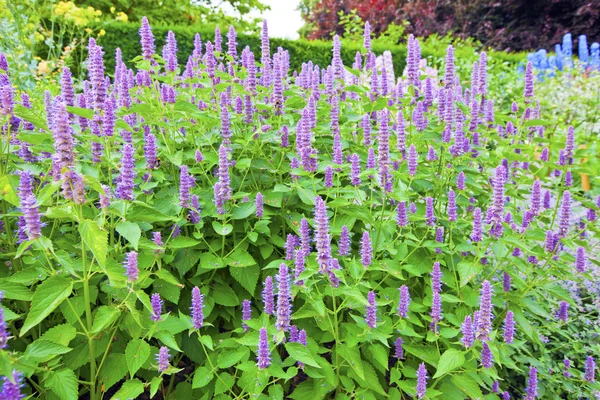
Prepare to encounter the aromatic wonders of Agastache, fondly referred to as “hummingbird mints” and “Giant hyssops.” Their 22 species, predominantly native to North America, exude a tantalizing charm. Hummingbirds find solace amidst their striking purple and red flowers, lovingly crafted from clusters of tiny blossoms. When summer’s embrace reaches its zenith, these resplendent blooms bloom in full splendor, drawing hummingbirds like moths to a flame.
To cultivate Agastache, begin their journey as indoor plants in May, subsequently transplanting them into your flower beds during the summer months. Allow the radiant sun to grace their presence, providing regular hydration in their early stages. Once established, these hardy desert plants revel in the searing heat, requiring minimal interference to flourish. Avoid excessive watering, granting them the freedom to bask in their natural glory.
– Common Name: Agastache
– Scientific Name: Agastache
– Growing Zones: 3 – 10
– Sun: Full Sun
– Soil: Lean soil, well-drained
– Colors: Blue, purple, red, orange, pink, white
– Height: 3 to 5 feet tall
– Spread: Varies
– Plant Type: Herbaceous perennial
4. Morning Glory
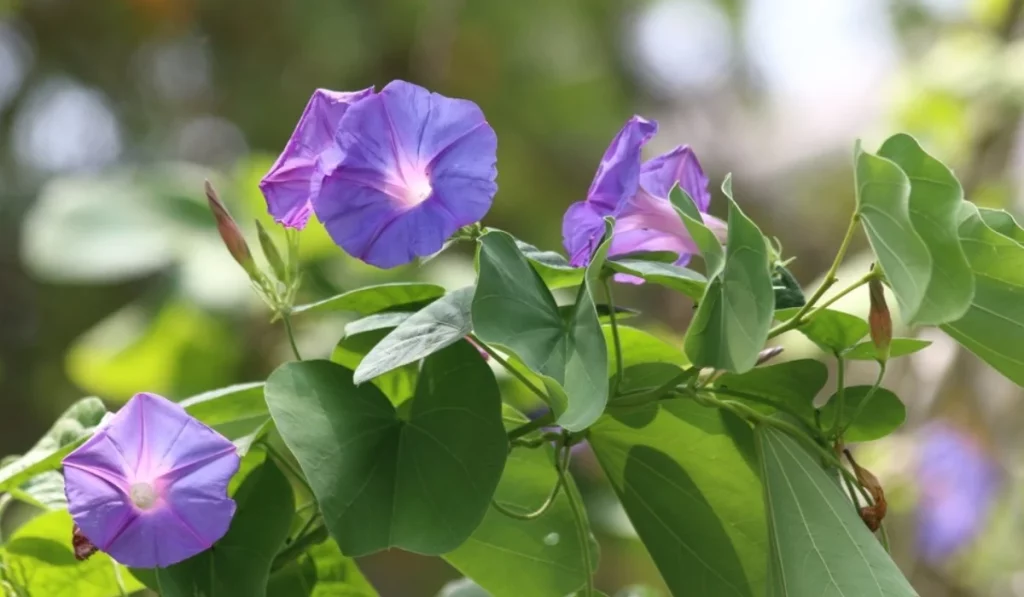
As the sun stretches its golden rays, the enchanting world of Morning Glory awakens. This captivating term encompasses over a thousand species, each boasting unique traits that dance upon the canvas of nature. Morning Glory’s petals unfurl at dawn, embracing the world in a tapestry of vibrant hues. The genus Convolvulaceae hosts this wondrous array, offering a symphony of colors and textures to adorn your gardens.
Within this abundant family, we encounter Ipomoea purpurea, hailed as the quintessential Morning Glory. Its resplendent purple, trumpet-shaped flowers, coupled with heart-shaped leaves, open in the embrace of morning and gently close as daylight recedes. From early summer to the first breaths of fall, these exquisite blooms transform your garden into a paradise, beckoning butterflies and hummingbirds to partake in their nectar-rich splendor.
While Morning Glory thrives as an annual vine, it may persist as a perennial in milder climates. Plant them directly in the sun’s warm embrace, allowing no more than eight hours of sunlight daily to witness their full bloom. However, do heed a note of caution, as their tenacious vines may pose a threat to the equilibrium of your garden. Furthermore, take care to shield children and pets from their toxic seeds.
– Common Name: Morning Glory
– Scientific Name: Convolvulaceae family
– Growing Zones: 2 – 11
– Sun: Full sun
– Soil: Moist, well-draining
– Colors: White, pink, purple, blue
– Height: 6 – 10 feet tall
– Spread: 3 – 6 feet wide
– Plant Type: Annual
5. Impatiens
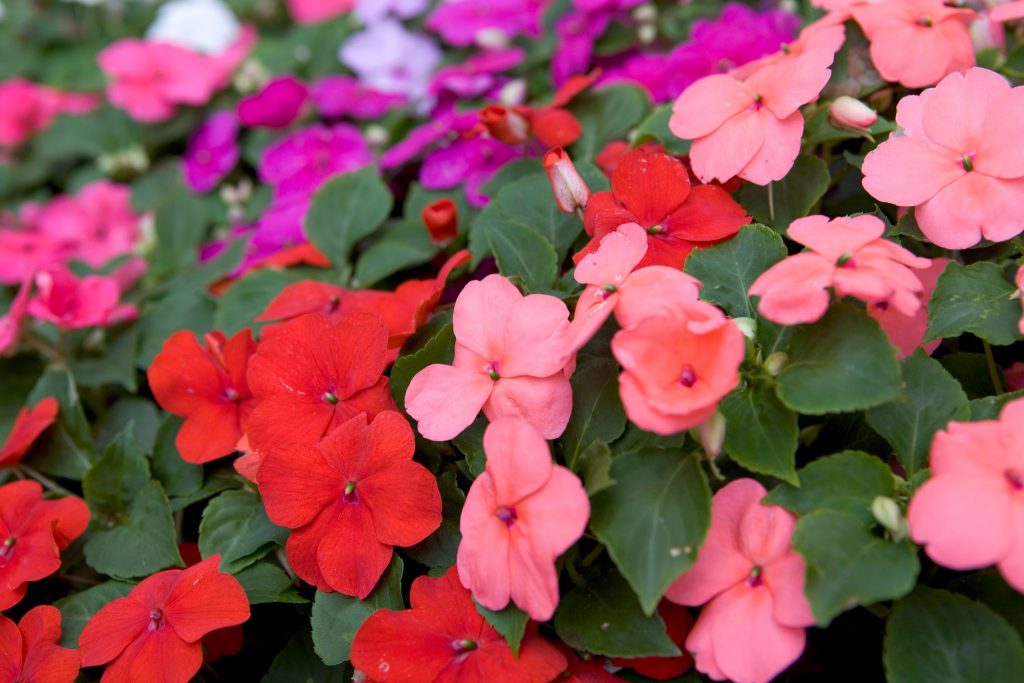
Immerse your garden in a riot of vibrant colors with the vivacious Impatiens. These bright annuals, resplendent in shades of red, pink, purple, yellow, and coral, possess the power to illuminate even the darkest corners. Embracing the realms of moisture and shade, they flourish in well-drained soil, embracing the gentle caress of deep shade. Cascading from hanging pots or gracing your porch, these enchanting blooms breathe life into every nook and cranny.
Whether nurtured from trays acquired at nurseries or sown from collected seeds, Impatiens spring forth, intertwining their flowers and leaves to create a dense, magnificent tapestry. As they bask in the sunlight, they reward your efforts with a profusion of blossoms, ensuring your garden radiates with their resplendent allure.
– Common Name: Impatiens
– Scientific Name: Impatiens
– Growing Zones: 2 – 11
– Sun: Shade or partial shade
– Soil: Rich, well-draining
– Colors: Red, pink, purple, yellow, coral
– Height: 6 – 36 inches
– Spread: 1 – 3 feet
– Plant Type: Annual
6. Columbine
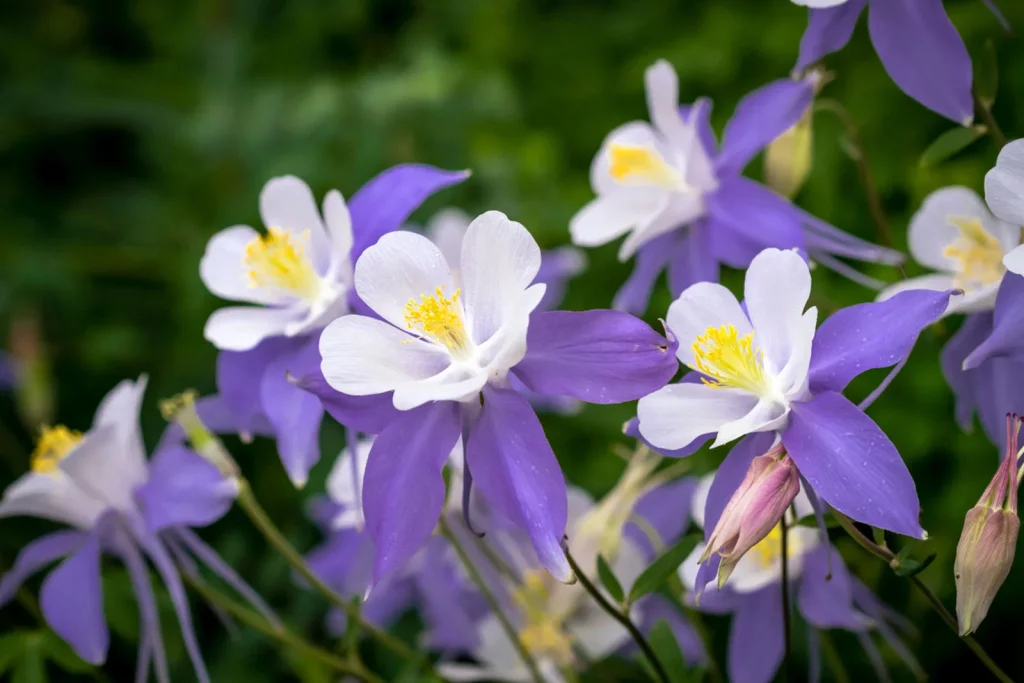
Venture into the captivating world of Columbine, where elegant perennial plants with spiky, bell-shaped blooms reign supreme. Also known as Aquilegia, these exquisite blossoms unfurl in an array of vibrant colors, adorning your garden with their charming presence. Flourishing in partial shade, Columbines embrace the subtle beauty of dappled sunlight.
Columbine’s distinctive bell-shaped blooms, spanning 3 to 6 inches, serve as a magnet for hummingbirds, who find solace amidst their delicate splendor. Shade-tolerant and drought-resistant, these resilient blooms bless your garden with their ethereal allure. Sowing Columbine seeds directly in spring or opting for indoor cultivation 6 to 8 weeks before the last frost ensures a bountiful display. Patience prevails, as these seed-grown wonders unfold their majestic petals in their second year.
– Common Name: Columbine
– Scientific Name: Aquilegia
– Growing Zones: 3-9
– Sun: Full sun to partial shade
– Soil: Neutral pH, moist but well-drained
– Colors: Red, pink, blue, orange, white, yellow
– Height: 1 – 3 feet
– Spread: 1 foot
– Plant Type: Perennial
7. Coneflower
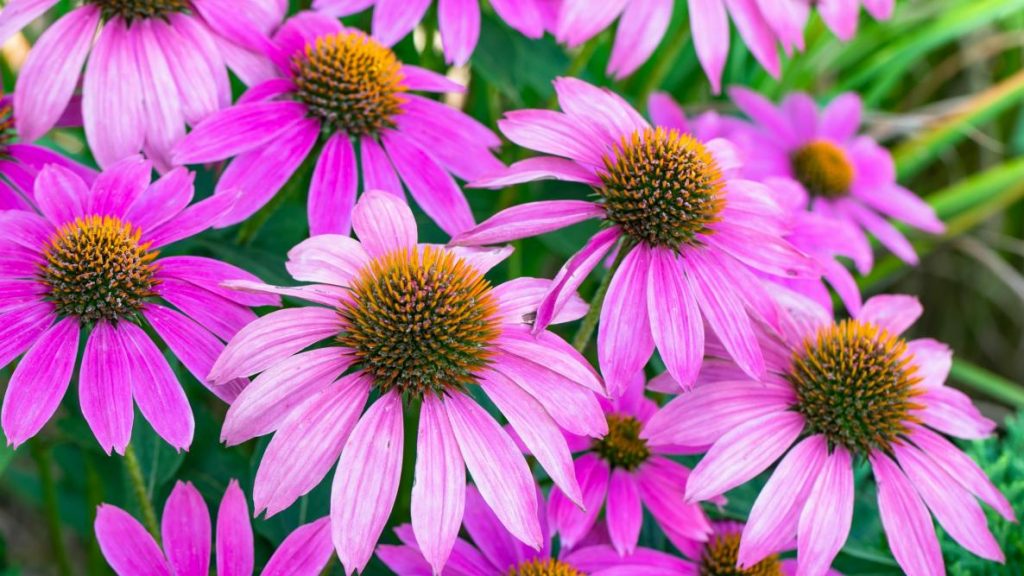
Prepare to lose yourself in the resplendent world of Coneflower, bestowed with the scientific name Echinacea. Belonging to the illustrious daisy family, Asteraceae, these striking flowers, lovingly resembling sea urchins, grace your garden with their radiant presence. With ten distinct species, these wondrous coneflowers showcase petals that gracefully descend upon blooming, forming captivating cones.
The common coneflower, Echinacea purpurea, reigns supreme, captivating hearts with its magnificent purple petals. Growing up to 5 feet in height, these captivating blossoms bloom from summer to fall, delighting the senses with their nectar-rich allure. Hummingbirds, butterflies, and bees find solace amidst their vivid colors, flocking to the delectable nectar encapsulated within their resplendent central cones.
Nestle these vibrant flowers under the nurturing embrace of full sunlight, granting them a well-drained soil to call home. Prepare to be mesmerized by their abundant blooms, each serving as a testament to the harmonious dance between nature and these captivating pollinators.
– Common Name: Coneflower
– Scientific Name: Echinacea
– Growing Zones: 3 – 9
– Sun: Full sun
– Soil: Varies
– Colors: White, yellow, orange, pink, red, purple, green
– Height: 2 to 5 feet tall
– Spread: 1 ½ – 2 feet wide
– Plant Type: Perennial
8. Penstemon
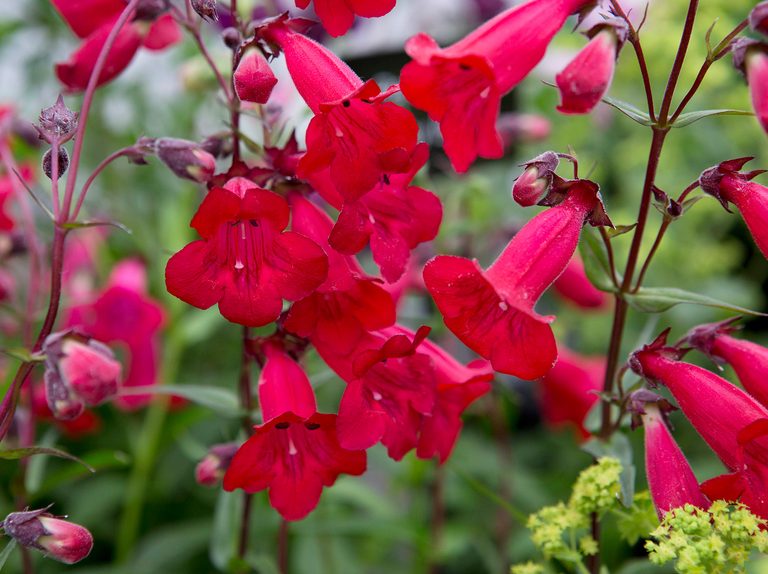
/m/loader/final_group_loader/Sarah Cuttle Gardeners World Live website 2015 /Images/
Embark on a journey through the kaleidoscopic wonders of Penstemon, a genus boasting over 250 ornamental flowering plants. These resplendent beings, akin to snapdragons and foxgloves, breathe life into your garden, beckoning hummingbirds and bees with their vibrant blooms. Bearded tongues, as their pollen-free stamens suggest, create a striking display of tubular flowers, forming clusters of splendor.
With an expansive array of varieties, Penstemon encompasses a spectrum of sizes and colors. Whether standing tall or low-growing, these hardy perennials boast resilience, requiring minimal care while radiating their brilliance. From shades of blue and purple to the fiery hues of red, orange, white, pink, and yellow, these captivating blooms offer a visual feast to enrapture both humans and hummingbirds alike.
Bathe these resilient Penstemons in full sunlight, granting them the opportunity to display their vibrant personalities. Lean, fast-draining soil serves as their preferred abode, as they dance harmoniously with the gentle rhythms of nature. Drought-tolerant and easy to care for, these remarkable blooms infuse your garden with an everlasting charm.
– Common Name: Penstemon
– Scientific Name: Penstemon
– Growing Zones: 3 – 9
– Sun: Full sun
– Soil: Lean, fast-draining soil
– Colors: Blue, purple, red, orange, white, pink, yellow
– Height: 6 to 12 inches, 1 to 3 feet, 3 to 8 feet
– Spread: 8 to 20 inches
– Plant Type: Perennial
9. Summersweet

Prepare to embrace the splendor of Summersweet, an enchanting flowering shrub destined to captivate both your heart and the hummingbirds’ affections. Scientifically known as Clethra alnifolia, this mesmerizing plant, native to eastern North America, thrives in a multitude of climates, but finds solace in the embrace of wetlands and the edges of ponds and streams.
Summersweet beckons with vertical spikes of spicy-scented white flowers, elegantly contrasting against their dark green foliage. As autumn unfurls its golden hues, these leaves transform, donning vibrant shades of yellow and gold. Their name, “pepperbush,” finds its origin in the resemblance of their seed capsules to peppercorns, cascading gently after the flowers bloom.
The resplendent flowers of Summersweet grace the stage between July and August, unfurling 2 to 6-inch blossoms in shades of white or pink. A tantalizing scent wafts through the air, attracting butterflies and hummingbirds to their delectable nectar. As a testament to their adaptation to coastal environments, Summersweet flourishes in moist to wet soil, reveling in the soothing embrace of shade. Unleash your nurturing instincts, for these shrubs endure even the salt-laden air, while their roots remain quenched by the gentle kiss of hydration.
Offer Summersweet the freedom to flourish, providing ample space for their captivating growth. Maintain the moisture within the soil and, during spring, prune old branches to foster new growth and shape their resplendent forms.
– Common Name: Summersweet, coastal sweet pepperbush
– Scientific Name: Clethra alnifolia
– Growing Zones: 3 – 9
– Sun: Full sun or partial shade
– Soil: Moist to wet soil, slightly acidic
– Colors: White, pink, or rose-colored
– Height: 4 – 8 feet tall
– Spread: 4 – 6 feet wide
– Plant Type: Perennial, Deciduous shrub
10. Yarrow

Embark on an odyssey through the world of Yarrow, where legend and nature intertwine. Its name, Achillea millefolium, pays homage to the mythical Greek hero Achilles, who reputedly used Yarrow to heal wounds suffered by his soldiers. A fascinating folklore accompanies this ancient remedy, earning Yarrow the moniker of “Nosebleed” due to its ability to induce or halt such epistaxis. “Millefolium,” translated as “thousand leaves,” alludes to the ethereal beauty of its feathery foliage, delicately divided into countless layers.
Yarrow, adorned with clusters of tiny flowers in white, yellow, pink, or red, graces your garden with its resplendent presence. These flowers stand united, forming an enchanting tapestry atop sturdy stems. Their soft, fern-like appearance and aromatic allure provide a breathtaking backdrop for hummingbirds, bees, and butterflies. As the seasons unfold, Yarrow unravels its majestic blooms, accompanied by a host of medicinal applications, ranging from wounds and burns to colds, fever, and headaches.
Welcome Yarrow into your garden with open arms, granting it the warmth of full sunlight and a well-drained, sandy, loamy or clay soil. As you embark on this harmonious journey, witness the transformation of your garden into a sanctuary of color and healing.
– Common Name: Yarrow, Common Yarrow, Milfoil, Nosebleed, Thousand-leaf
– Scientific Name: Achillea millefolium
– Growing Zones: 3 – 9
– Sun: Full sun
– Soil: Sandy, loamy, clay, well-draining
– Colors: White, yellow, pink, red
– Height: 2 to 3 feet tall
– Spread: 2 to 3 feet wide
– Plant Type: Perennial
11. Butterfly Weed
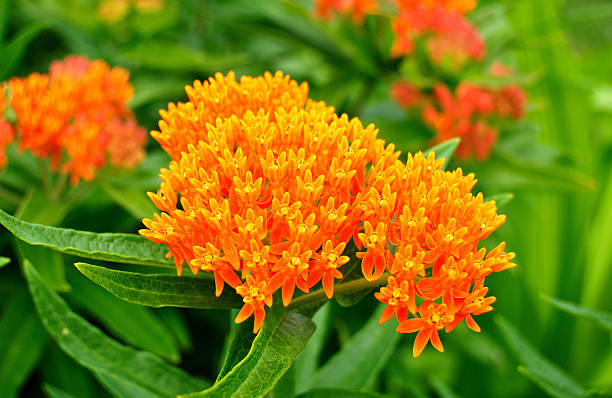
Step into the realm of Butterfly Weed, where the resplendent Asclepias tuberosa unveils its vibrant presence. Embracing its role as a bushy perennial, this captivating plant, also known as Pleurisy Root, enchants both the eyes and the senses. Despite belonging to the Milkweed family, this alluring bloom eschews the traditional milky sap, earning the moniker “Orange Milkweed.”
Butterfly Weed boasts long, bright red tubular flowers, intricately designed to accommodate the long bills of hummingbirds. As summer graces your garden, these nectar-rich blooms grace the stage, their fiery hues captivating the hearts of both hummingbirds and pollinators. Nestled amid a lush, bright green foliage, these magnificent flowers transform your garden into a sanctuary of color and life.
Grant Butterfly Weed the comfort of moist soil, never allowing it to dry out. Whether nestled in the earth or cradled in pots, ensure a tray of water supports their journey, nurturing their thirst with ease. Embrace the harmonious dance between these captivating blooms and the delicate creatures they beckon, playing a vital role in the preservation of monarch butterflies and their caterpillars.
– Common Name: Butterfly Weed, Butterfly Flower, Orange Milkweed, Pleurisy Root
– Scientific Name: Asclepias tuberosa
– Growing Zones: 3 – 9
– Sun: Full sun
– Soil: Poor, dry, well-drained soil
– Colors: Orange, yellow, red
– Height: 1 to 2 feet tall
– Spread: 12 to 18 inches wide
– Plant Type: Perennial
12. Hydrangea
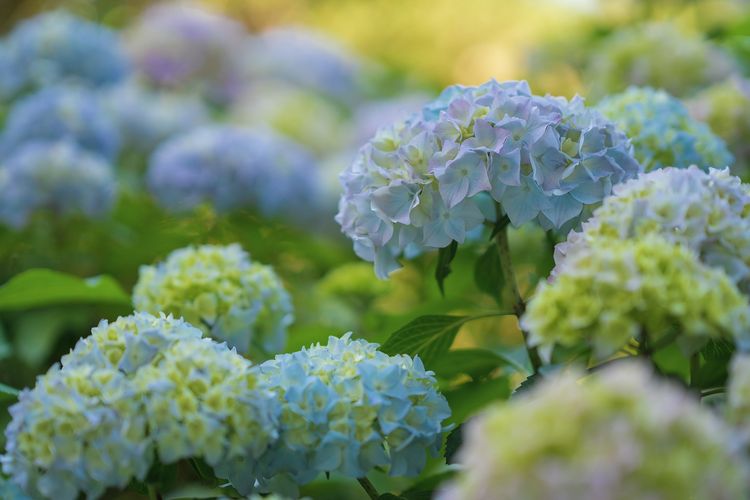
Prepare to immerse your garden in the splendor of Hydrangeas, where colossal flower heads grace shady realms with their enchanting presence. These showy plants, resistant to the scorching heat, find solace in the embrace of shade, particularly during the sun-drenched afternoons.
Hydrangeas, masters of transformation, greet your garden with an extravagant display from spring to the peak of fall, adorning your sanctuary with an array of captivating hues. Their immense flower heads, reminiscent of a floral symphony, stand tall, radiating their captivating aura. With colors spanning from pink, red, white, blue, to the unique shade of green, they offer a breathtaking panorama, enriching your garden throughout the changing seasons.
Nurturing Hydrangeas is a joyous endeavor, demanding little in return. They appreciate a weekly drenching, their thirst quenched by the gentle flow of water, especially during dry spells. Pruning, a gentle act carried out in the winter, awaits the demise of their blossoms, ensuring a reinvigorated display in the forthcoming seasons.
Welcome Hydrangeas to your garden oasis, allowing their resplendent blooms to infuse your sacred space with their timeless allure.
– Common Name: Hydrangea
– Scientific Name: Hydrangea
– Growing Zones: 3 – 9
– Sun: Full sun to shade
– Soil: Fertile, well-draining
– Colors: Pink, red, white, blue, green
– Height: 3 – 15 ft
– Spread: 2 – 12 feet
– Plant Type: Perennial
13. Veronica

Embark on an adventure through the boundless realms of Veronica, a flowering plant boasting a staggering 500 species. These herbaceous perennials, adorning the illustrious Plantaginaceae family, beckon with their resplendent blooms. Spanning temperate regions of the Northern Hemisphere, these captivating beings forge a harmonious union between humans and nature.
Veronicas, boasting an extensive array of varieties, entice with their low-growing forms, perfect as enchanting ground covers. Springtime awakens their delicate splendor, as their flowers bloom amidst the tapestry of life. Yet, Veronicas also reach for the heavens, their upright, vertical flower spikes captivating all who encounter them. Amidst shades of blue, purple, red, orange, white, pink, and yellow, they offer a visual feast to enchant both the human eye and the hummingbird’s ethereal flight.
Endowed with resilience, these wonders thrive in full sunlight, their vibrant personalities unveiled as they bask in the nourishing rays. Lean, fast-draining soil embraces their roots, providing the canvas upon which their kaleidoscopic blooms flourish. Drought-tolerant and easy to care for, Veronicas reward your endeavors with a flourishing garden and the arrival of enchanting pollinators.
Welcome Veronicas into your realm, granting them the opportunity to weave their tapestry of colors, while nature and humanity dance in unison.
– Common Name: Veronica, Speedwell
– Scientific Name: Genus Veronica from the family Plantaginaceae
– Growing Zones: 3 – 11
– Sun: Full sun, partial shade
– Soil: Well-drained
– Colors: Blue, purple, red, orange, white, pink, yellow
– Height: 6 inches to 3 feet tall
– Spread: 6 inches to 2 feet wide
– Plant Type: Perennial
14. Bleeding Heart
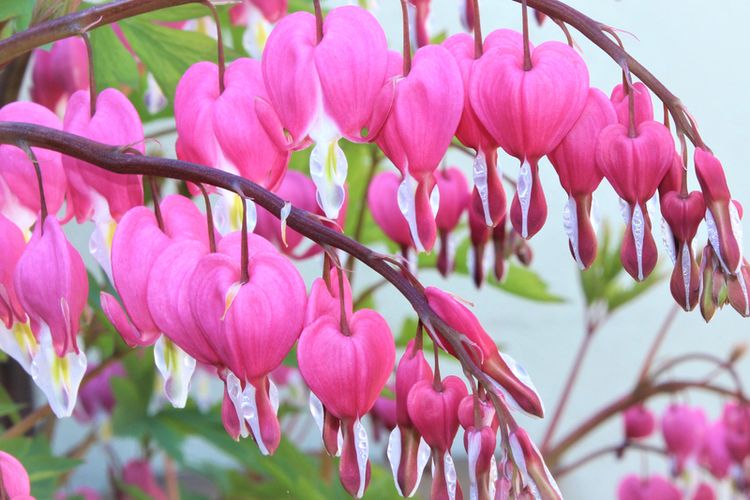
Enter the ethereal realm of Bleeding Heart, where delicate flowers cascade in a symphony of grace. Known as Dicentra spectabilis in the scientific realm, this perennial treasure demands minimal maintenance while gracing your garden with its enchanting presence. Unfolding its majestic blooms in full sun or partial shade, Bleeding Heart unveils a world of captivating beauty.
The resplendent flowers of Bleeding Heart, offering shades of red, white, and pink, bloom during the spring, permeating the air with their sweet scent. With a penchant for shady corners, these charming blooms imbue hanging baskets with an otherworldly allure. While the scorching sun may cause them to retreat, their roots remain resilient, eager to revive in the following year. Bestow upon them the gift of regular watering during the growing season, allowing the soil to remain moist, a haven for their delicate existence.
As autumn ushers in its golden embrace, Bleeding Heart bids farewell, its leaves turning yellow before the final bow. With careful precision, you may prune them back once they begin to yellow, welcoming the promise of rebirth.
Embrace the delicate charm of Bleeding Heart, a testament to the ephemeral nature of life and the enduring beauty it bestows upon us.
– Common Name: Bleeding Heart
– Scientific Name: Dicentra spectabilis
– Growing Zones: 3 – 9
– Sun: Partial shade
– Soil: Well-drained, moist
– Colors: Red, white, pink
– Height: 3 feet
– Spread: 3 feet
– Plant Type: Perennial
15. Cardinal Flower
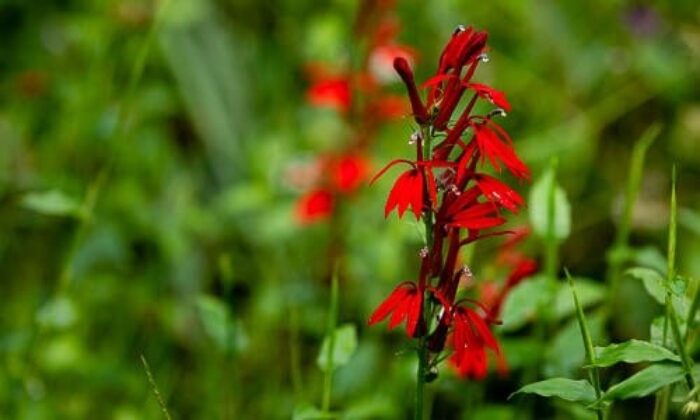
Immerse yourself in the enchanting allure of Cardinal Flower, where long tubular blossoms donning vibrant shades of red, pink, and white captivate the senses. Scientifically known as Lobelia cardinalis, this herbaceous perennial boasts regal elegance, beckoning hummingbirds with its resplendent beauty.
As late summer arrives, the bright red flowers of Cardinal Flower grace your garden, their slender tubes reaching for the heavens. Delicate and alluring, they stand as a testament to the wonders of nature. Yet, these captivating blooms harbor a secret—they yearn for moist soil, never willing to relinquish their hydration. Offer them the gift of a tray, brimming with water, cradling their roots, allowing them to flourish in the embrace of your garden.
Welcome the exquisite Cardinal Flower, a harmony of color and life, as it dances with hummingbirds, forging a bond that transcends the boundaries of the natural world.
– Common Name: Cardinal flower
– Scientific Name: Lobelia cardinalis
– Growing Zones: 3 – 9
– Sun: Full sun to partial shade
– Soil: Rich, moist
– Colors: Red, pink, white
– Height: 2 – 4 feet
– Spread: 1 – 2 feet
– Plant Type: Perennial
16. Phlox

Step into the world of Phlox, a genus of enchanting flowering plants that ignite the senses with their vibrant colors. Derived from the Greek word for “Flame,” Phlox captivates with its intensely-colored blooms. Within this genus, three common types exist: Creeping Phlox (Phlox subulata), Woodland Phlox (Phlox stolonifera/divaricata), and Garden Phlox (Phlox paniculata).
Creeping Phlox, with its low and wide growth pattern, gracefully blankets the ground, making it the perfect choice for ground covers. Woodland Phlox, of medium height, fills gaps with its beauty, while Garden Phlox, tall and erect, commands attention even from the back of the garden.
Phlox flowers, delicate and fragrant, cluster in groups of twelve atop sturdy stems. These charming blooms come in a myriad of colors, ranging from shades of white, pink, red, purple, to blue.
While their profusion of flowers may overshadow their leaves, Phlox foliage is deserving of admiration. The leaves vary in shape, from oblong and pointed to lance-shaped, and showcase shades of bright or deep green, some even sporting colorful borders.
Hummingbirds and other pollinators are irresistibly drawn to the allure of Phlox, as these resilient plants thrive with minimal care. With occasional watering and ample sunlight, Phlox graces your garden with its captivating presence.
– Common Name: Garden Phlox, Creeping Phlox, Woodland Phlox
– Scientific Name: Phlox
– Growing Zones: 2 – 9
– Sun: Full sun, part sun, shade
– Soil: Moist, fertile soil with a layer of compost
– Colors: White, pink, red, purple, blue
– Height: 4 to 6 inches, 8 to 12 inches, 2 to 4 feet tall
– Spread: 4 to 6 inches wide, 8 to 12 inches wide, 2 to 3 feet wide
– Plant Type: Perennial
17. Viburnum
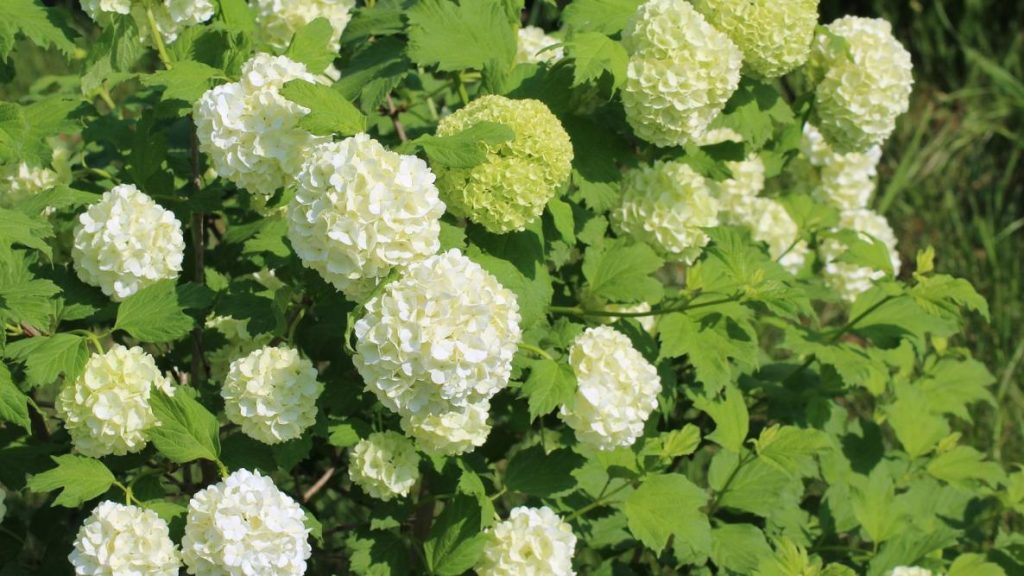
Transport yourself into the world of Viburnum, a captivating genus comprising over 150 species of flowering plants. Once part of the honeysuckle family, Viburnum now resides in the Adoxaceae family. These deciduous shrubs and trees adorn temperate regions of North America and tropical regions of Southeast Asia.
Viburnum entices with its nectar-rich, shapely flowers, which beckon hummingbirds and butterflies to partake in their splendor. Among their captivating features are intoxicating fragrances, exhibited by varieties like Cayuga and Burkwood. The leaves of Viburnum also display intriguing hues, such as purplish-red or blue-green, adding to their allure. Furthermore, their berries showcase a vibrant array of colors, including red, pink, purple, blue, and black.
The flowering season for most Viburnum varieties spans from early spring to late summer, while some, like the Bodnant Viburnum, bloom even in winter. As their flowers fade, these remarkable plants give way to brilliantly-colored fruits and captivating fall foliage, creating a spectacle of nature’s beauty.
Most Viburnums thrive in full sun, relishing approximately six hours of sunlight daily to showcase their magnificent flowers, bountiful fruits, and mesmerizing fall foliage. While their sunlight needs may vary, they all prefer well-draining soil and benefit from pruning to remove old, dead, and broken branches.
Welcome Viburnum to your backyard, and witness the harmonious interplay of fragrance, colorful flowers, foliage, and eye-catching fruits. Hummingbirds will undoubtedly find their way to these splendid plants.
– Common Name: Viburnum
– Scientific Name: Viburnum
– Growing Zones: 2 – 9
– Sun: Full sun, partial sun
– Soil: Moist but well-drained soil
– Colors: White, pink
– Height: 3 – 8 feet, 8 – 20 feet
– Spread: 3 to 12 feet wide, depending on the type
– Plant Type: Perennial, Evergreen, Deciduous shrub
18. English Hawthorn
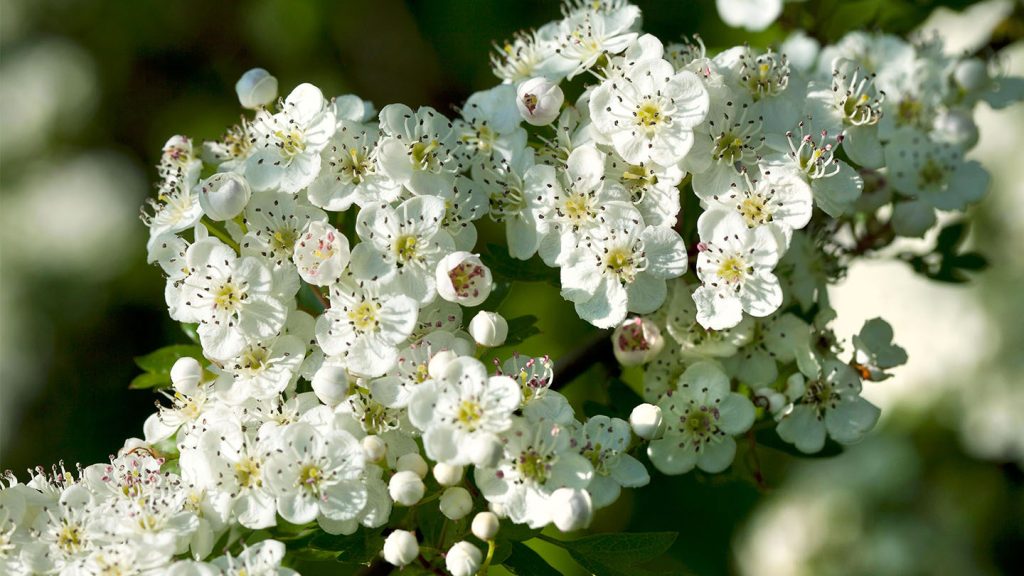
Step into the realm of the English Hawthorn (Craetaegus Laevigata), also known as Midland hawthorn or Woodland hawthorn. This deciduous, thorny tree originated in Europe and North Africa, akin to apple, pear, and crabapple trees that bloom abundantly during spring.
English Hawthorn trees, reaching heights of up to 30 feet, possess remarkable resilience, tolerating drought and poor soil conditions. This adaptability allows them to thrive even in confined spaces, making them popular choices for street trees, landscapes, and bonsai cultivation.
During springtime, English Hawthorn trees don radiant colors, encompassing white, pink, lavender, and red. These exquisite flowers, adorning flat clusters of 6 to 12 blossoms, each boasting five petals, grace the branches. As the flowers wane, small red or orange fruits emerge, gracing the tree from summer through winter. These vividly colored fruits provide a striking contrast against the winter landscape.
When planting English Hawthorn, it is prudent to select a location where fallen fruit will not pose a concern. While they grow slowly, they can live up to 150 years, enriching your surroundings with their enduring beauty.
– Common Name: English Hawthorn, Midland hawthorn, or Woodland hawthorn
– Scientific Name: Craetaegus Laevigata
– Growing Zones: 3 – 9
– Sun: Full sun
– Soil: Moist, well-drained
– Colors: White, pink, lavender, red
– Height: 6 to 30 feet tall
– Spread: 6 to 30 feet wide
– Plant Type: Perennial, Deciduous tree
19. Delphinium
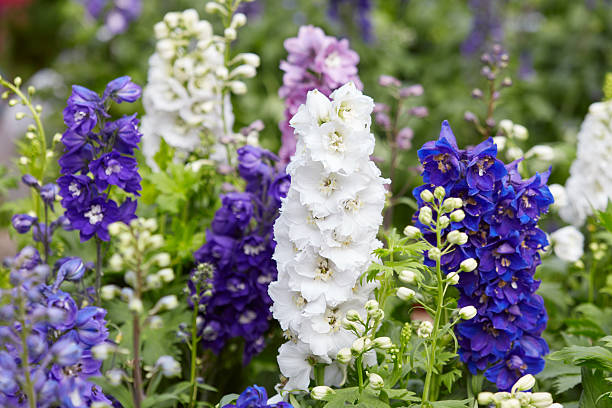
Embark on a journey through the mesmerizing world of Delphiniums, a genus boasting approximately 300 species of flowering plants belonging to the Ranunculaceae family. Delphiniums are renowned for their tall, colorful, and nectar-rich flowers, inviting butterflies, bees, and hummingbirds to revel in their splendor.
Gardeners are captivated by the allure of Delphiniums, particularly their rare blue flowers, despite their toxicity and somewhat demanding growing conditions. However, Delphiniums do not disappoint in terms of color diversity, as they also bloom in captivating shades of pink and red. These flowers grace the garden from late spring to late summer, providing a feast for the eyes.
Delphiniums can grow as tall as 8 feet, boasting palm-shaped leaves that add to their visual appeal. These enchanting plants thrive in full sun, though they may require some protection from excessive heat and strong winds. Additionally, supporting their stalks may be necessary as they grow vertically.
Each Delphinium flower boasts a profusion of nectar, serving as a magnet for hummingbirds. The vibrant colors of these flowers, combined with the abundant nectar, guarantee repeated visits from pollinators.
– Common Name: Larkspur, Delphinium
– Scientific Name: Delphinium
– Growing Zones: 3 – 7
– Sun: Full sun, part shade
– Soil: Well-draining soil
– Colors: White, pink, red, purple, blue
– Height: 1 to 3, 3 to 8 feet tall
– Spread: 1 to 3 feet wide
– Plant Type: Perennial
20. Daylily
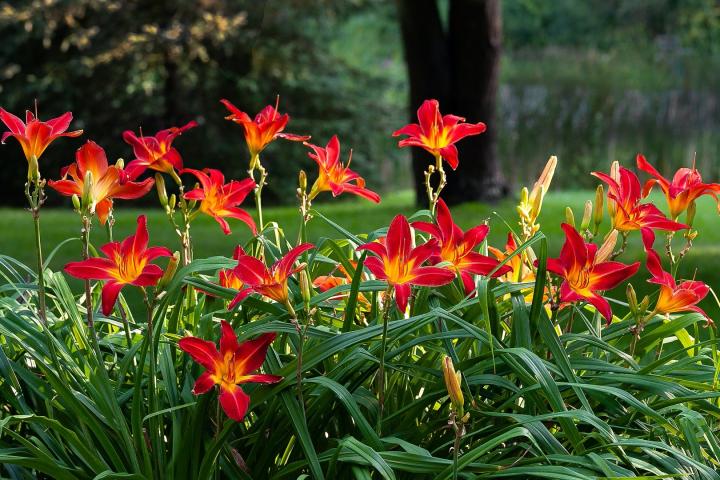
Immerse yourself in the enchanting world of Daylilies, perennial plants belonging to the Asphodelaceae family. Revered by gardeners for their captivating flowers, Daylilies have given rise to approximately 35,000 cultivars, offering a plethora of color variations, plant hardiness, disease resistance, and sturdiness.
Daylilies, despite their name, are not true lilies. They sprout from fleshy roots rather than onion-like bulbs. The flowers blossom on leafless stems, known as “scapes,” each bearing 12 to 15 buds. With multiple scapes per mature plant, Daylilies grace the garden with an abundance of blooms from mid-spring to fall.
The flowers of Daylilies last only a day, but fear not, for new flowers emerge to continue the spectacular display. A continuous cycle of blooming occurs throughout the season, ensuring a constant supply of resplendent flowers.
To ensure an abundant display of brilliantly colored flowers, Daylilies thrive in areas that receive at least six hours of sunlight. While they exhibit drought tolerance, it is crucial to provide adequate watering, especially during scape and bud formation.
Hummingbirds are easily enticed by the vivid colors of Daylilies, particularly the reds and purples. They are especially drawn to the tubular varieties, which hold the most nectar.
– Common Name: Daylily
– Scientific Name: Genus Hemerocallis
– Growing Zones: 4 – 9
– Sun: Full sun
– Soil: Slightly acidic to neutral
– Colors: White, yellow, orange, pink, red, purple
– Height: 3 to 4 feet tall
– Spread: 2 to 4 feet wide
– Plant Type: Perennial
21. Coneflower
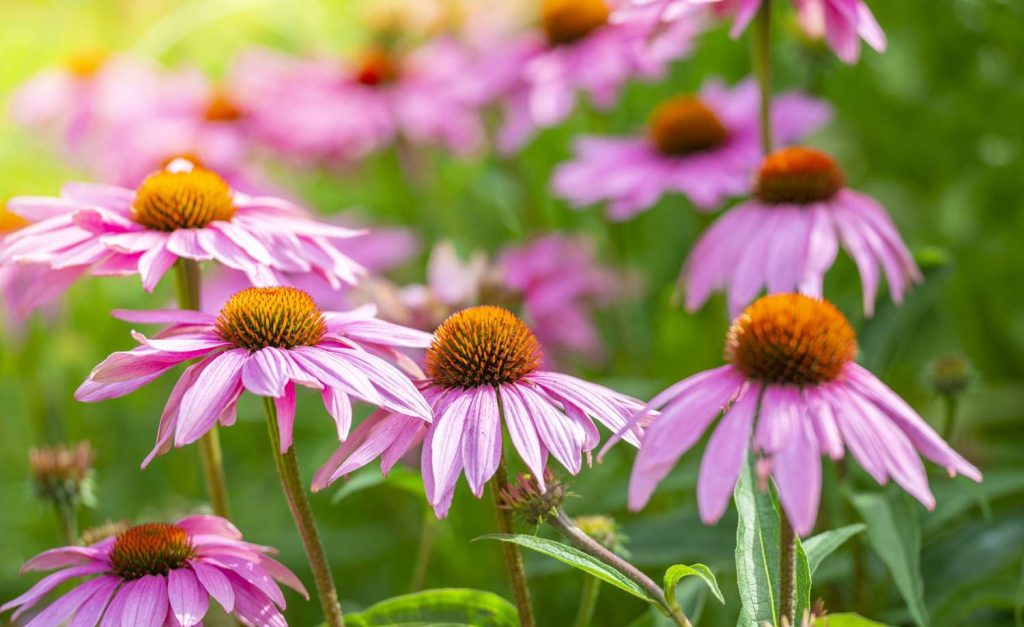
Enter the realm of the Coneflowers, a genus of flowering plants known as Echinacea. These delightful perennials, native to North America, have become garden favorites due to their vibrant daisy-like flowers and their ability to attract pollinators such as bees and butterflies.
Coneflowers are known for their distinctive center cones, surrounded by colorful ray petals that can range from shades of pink and purple to white. These flowers bloom from early summer to fall, creating a stunning display of color in the garden. Beyond their visual appeal, Coneflowers also possess medicinal properties and are often used in herbal remedies.
These hardy plants are adaptable and can thrive in a variety of growing conditions. They prefer full sun but can tolerate partial shade. Coneflowers are drought-tolerant and can withstand dry spells, making them suitable for low-maintenance gardens. They also have a long blooming period and are known to attract beneficial insects, making them a valuable addition to any garden.
– Common Name: Coneflower
– Scientific Name: Echinacea
– Growing Zones: 3 – 9
– Sun: Full sun to part shade
– Soil: Well-drained soil
– Colors: Pink, purple, white
– Height: 2 to 5 feet tall
– Spread: 1 to 2 feet wide
– Plant Type: Perennial
22. Balloon Flower

Discover the whimsical beauty of the Balloon Flower (Platycodon grandiflorus), a perennial plant that hails from East Asia. Named after its unique balloon-like buds, which open to reveal star-shaped flowers, this plant is a delightful addition to any garden.
Balloon Flowers are known for their showy blooms that come in shades of blue, purple, pink, and white. The buds swell up like inflated balloons before bursting open into five petals, creating a charming spectacle. These flowers bloom from mid-summer to early fall, attracting butterflies and other pollinators to the garden.
Aside from their enchanting flowers, Balloon Flowers are also valued for their hardiness and ease of care. They prefer full sun to partial shade and can tolerate a wide range of soil conditions. These plants are relatively low maintenance and can even withstand dry spells once established.
Balloon Flowers are well-suited for borders, rock gardens, or containers, adding a touch of whimsy and color to any landscape.
– Common Name: Balloon Flower
– Scientific Name: Platycodon grandiflorus
– Growing Zones: 3 – 8
– Sun: Full sun to part shade
– Soil: Well-drained soil
– Colors: Blue, purple, pink, white
– Height: 1 to 3 feet tall
– Spread: 1 to 2 feet wide
– Plant Type: Perennial
23. Black-Eyed Susan

Delve into the world of Black-Eyed Susans (Rudbeckia hirta), cheerful and vibrant perennials native to North America. These flowers are a classic choice for gardens, known for their sunny yellow petals and distinct dark brown or black centers.
Black-Eyed Susans are members of the sunflower family and bear a striking resemblance to their larger relatives. They bloom from mid-summer to early fall, attracting bees, butterflies, and other pollinators with their nectar-rich flowers. Their bright colors and ability to thrive in various conditions make them a popular choice for wildflower gardens and meadows.
These hardy plants prefer full sun but can tolerate partial shade. They are adaptable to a wide range of soil conditions, making them suitable for various garden settings. Black-Eyed Susans are drought-tolerant once established, making them an excellent choice for low-maintenance
landscapes.
– Common Name: Black-Eyed Susan
– Scientific Name: Rudbeckia hirta
– Growing Zones: 3 – 9
– Sun: Full sun to part shade
– Soil: Well-drained soil
– Colors: Yellow, sometimes with orange or mahogany highlights
– Height: 1 to 3 feet tall
– Spread: 1 to 2 feet wide
– Plant Type: Perennial
24. Blanket Flower
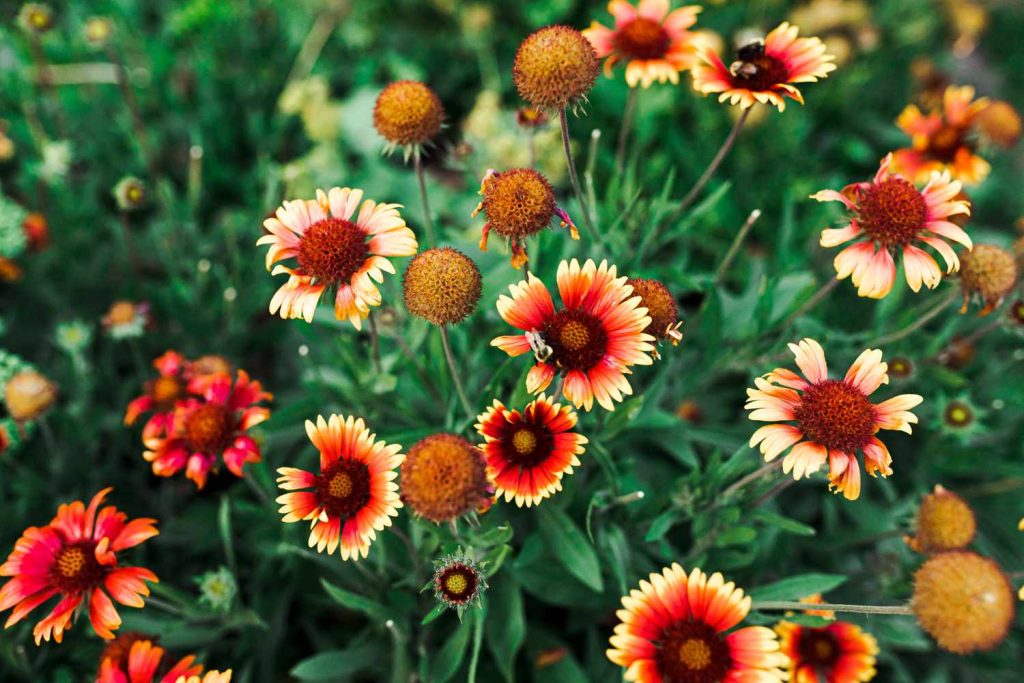
Embrace the vibrant beauty of the Blanket Flower (Gaillardia), a stunning perennial native to North and South America. This cheerful flower gets its name from its striking resemblance to a colorful blanket, with its vibrant petals and contrasting center.
Blanket Flowers come in a variety of colors, including shades of red, orange, yellow, and combinations thereof. Their daisy-like flowers bloom from early summer to fall, attracting butterflies and other pollinators to the garden. The eye-catching petals and prominent central disks make the Blanket Flower a standout in any landscape.
These resilient plants are well-suited to sunny areas and can tolerate a range of soil conditions, including poor or rocky soil. They are drought-tolerant and low maintenance, making them an excellent choice for gardens that require minimal care.
With their bright colors and ability to thrive in challenging conditions, Blanket Flowers bring a cheerful and lively touch to borders, meadows, and containers.
– Common Name: Blanket Flower
– Scientific Name: Gaillardia
– Growing Zones: 3 – 10
– Sun: Full sun
– Soil: Well-drained soil
– Colors: Red, orange, yellow
– Height: 1 to 3 feet tall
– Spread: 1 to 2 feet wide
– Plant Type: Perennial
25. Columbine
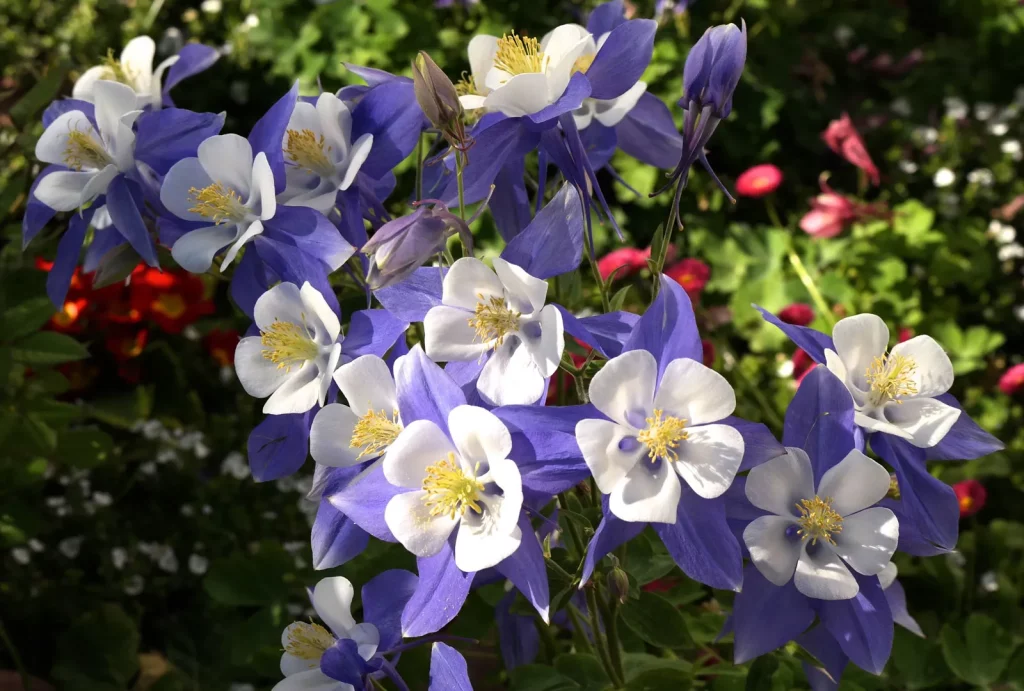
Delve into the enchanting world of Columbines (Aquilegia), delicate and graceful perennials that add a touch of elegance to any garden. With their unique spurred flowers and attractive foliage, Columbines are beloved by both gardeners and hummingbirds alike.
Columbine flowers come in a variety of colors, including shades of pink, purple, blue, yellow, and white. The distinct shape of the flowers, with their long spurs extending backward, gives them a whimsical and ethereal appearance. The flowers bloom from late spring to early summer, attracting hummingbirds and bees with their nectar-rich blooms.
Beyond their beautiful flowers, Columbines also feature attractive fern-like foliage, adding texture and interest to the garden even when the flowers are not in bloom. They prefer partial shade but can tolerate full sun in cooler climates. Columbines are adaptable to a variety of soil conditions and are generally low maintenance.
Whether planted in borders, woodland gardens, or containers, Columbines bring a touch of grace and charm to any outdoor space.
– Common Name: Columbine
– Scientific Name: Aquilegia
– Growing Zones: 3 – 9
– Sun: Partial shade to full sun (in cooler climates)
– Soil: Well-drained soil
– Colors: Pink, purple, blue, yellow, white
– Height: 1 to 3 feet tall
– Spread: 1 to 2 feet wide
– Plant Type: Perennial
26. Penstemon

Embrace the beauty of Penstemons, a diverse genus of flowering plants native to North America. With their elegant tubular flowers and vibrant colors, Penstemons are a favorite among gardeners and hummingbirds alike.
Penstemon flowers come in a range of colors, including shades of red, pink, purple, blue, and white. The tubular shape of the flowers is perfectly suited for hummingbirds, who are drawn to their nectar-filled blooms. The flowers bloom from late spring to summer, creating a stunning display of color and attracting pollinators to the garden.
These versatile plants thrive in a variety of growing conditions, from full sun to partial shade. They prefer well-drained soil and are generally drought-tolerant once established. With their long flowering period and ability to attract hummingbirds, Penstemons are a valuable addition to any garden.
Whether planted in borders, rock gardens, or containers, Penstemons bring a touch of elegance and vibrancy to outdoor spaces.
– Common Name: Penstemon
– Scientific Name: Penstemon
– Growing Zones: Varies depending on species
– Sun: Full sun to partial shade
– Soil: Well-drained soil
– Colors: Red, pink, purple, blue, white
– Height: Varies depending on species
– Spread: Varies depending on species
– Plant Type: Perennial
27. Fuchsia
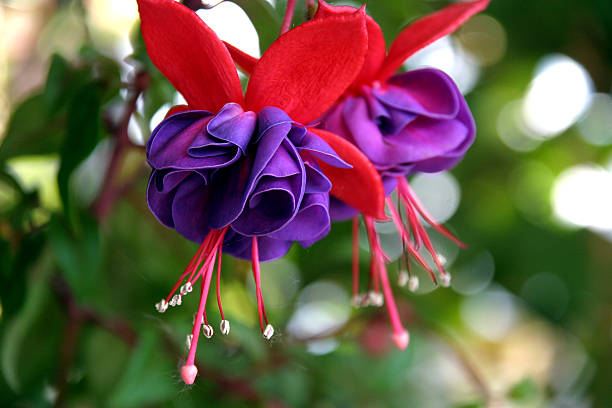
Indulge in the enchanting beauty of Fuchsias, captivating flowering plants known for their exquisite blooms and ability to attract hummingbirds. With their pendulous flowers and vibrant colors, Fuchsias bring an element of elegance to any garden or hanging basket.
Fuchsia flowers come in a variety of colors, including shades of red, pink, purple, and white. The intricate shape of the flowers, with their slender petals and contrasting sepals, adds a touch of sophistication to the garden. The flowers bloom from spring to fall, providing a continuous display of beauty and attracting hummingbirds with their nectar.
These versatile plants prefer partial shade and well-drained soil. They are perfect for hanging baskets, where their cascading branches and colorful flowers create a stunning visual display. Fuchsias require regular watering to keep the soil consistently moist but not waterlogged.
With their graceful blooms and ability to thrive in shaded areas, Fuchsias are a charming addition to any outdoor space.
– Common Name: Fuchsia
– Scientific Name: Fuchsia
– Growing Zones: Varies depending on species
– Sun: Partial shade
– Soil: Well-drained soil
– Colors: Red, pink, purple, white
– Height: Varies depending on species
– Spread: Varies depending on species
– Plant Type: Perennial
28. Cardinal Flower
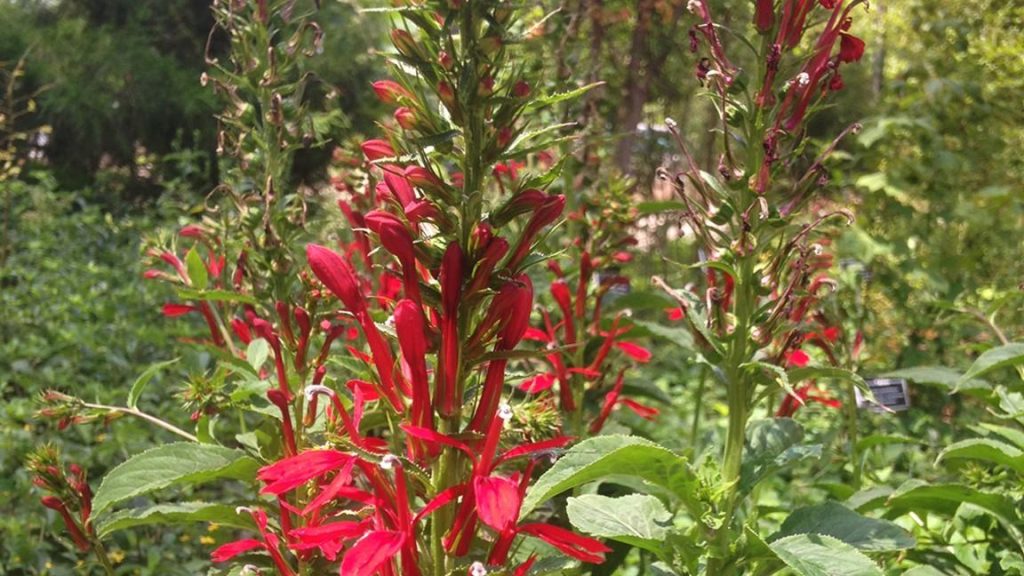
Immerse yourself in the radiant beauty of the Cardinal Flower (Lobelia cardinalis), a striking perennial that attracts both hummingbirds and human admirers with its vivid red blooms. Native to North America, the Cardinal Flower is a true showstopper in any garden.
The Cardinal Flower features tall spikes of vibrant red flowers, which bloom from mid-summer to early fall. The tubular shape of the flowers and their rich color make them irresistible to hummingbirds, who eagerly feed on their nectar. The flowers rise above the attractive green foliage, creating a stunning focal point in the landscape.
These plants prefer moist soil and thrive in partial shade to full sun. They are an excellent choice for rain gardens, boggy areas, or near water features. Cardinal Flowers require consistent moisture and regular watering to flourish.
With their dramatic red flowers and ability to attract hummingbirds, Cardinal Flowers bring a touch of elegance and vibrancy to gardens and naturalistic landscapes.
– Common Name: Cardinal Flower
– Scientific Name: Lobelia cardinalis
– Growing Zones: 3 – 9
– Sun: Partial shade to full sun
– Soil: Moist, well-drained soil
– Colors: Red
– Height: 2 to 4 feet tall
– Spread: 1 to 2 feet wide
– Plant Type: Perennial
29. Agastache
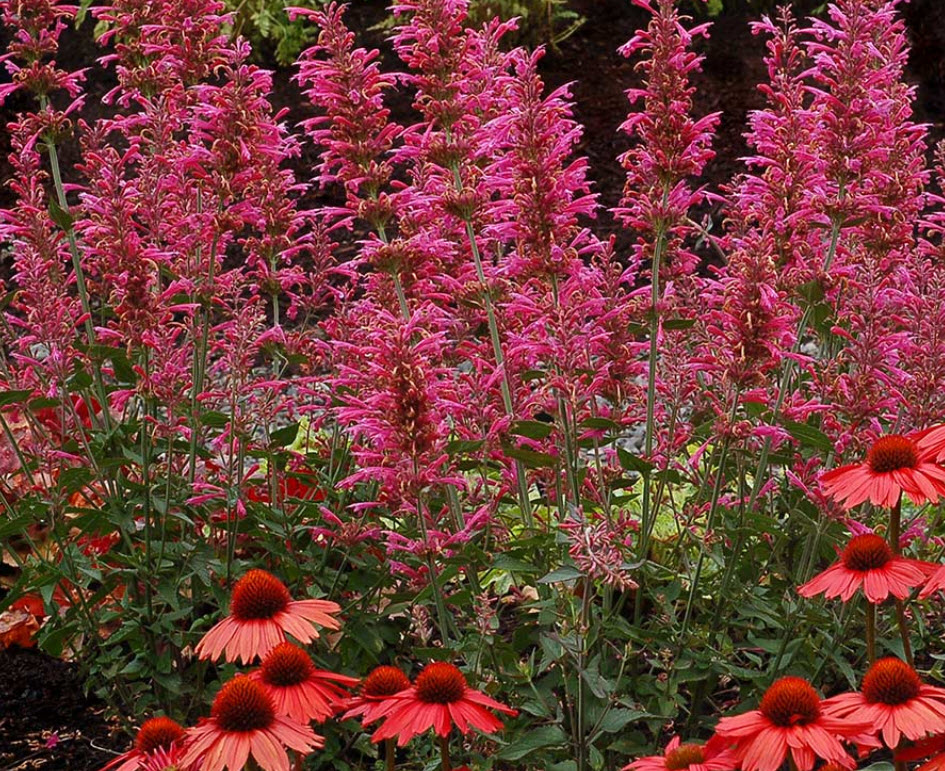
Delight in the captivating beauty and fragrance of Agastache, a genus of flowering plants that are beloved by hummingbirds and garden enthusiasts alike. With their abundant spikes of colorful flowers and aromatic foliage, Agastache adds a touch of charm and vibrancy to any garden.
Agastache flowers come in a range of colors, including shades of purple, pink, orange, and blue. The tall spikes of tubular flowers bloom from mid-summer to fall, attracting hummingbirds and butterflies with their abundant nectar. The aromatic foliage adds another layer
of interest, releasing a pleasant scent when brushed against.
These plants prefer full sun and well-drained soil. They are drought-tolerant once established and attract beneficial pollinators to the garden. Agastache is a versatile plant that can be used in borders, cottage gardens, or as a focal point in containers.
With their vibrant colors, delightful fragrance, and ability to attract hummingbirds, Agastache plants are a wonderful addition to any garden.
– Common Name: Agastache
– Scientific Name: Agastache
– Growing Zones: Varies depending on species
– Sun: Full sun
– Soil: Well-drained soil
– Colors: Purple, pink, orange, blue
– Height: Varies depending on species
– Spread: Varies depending on species
– Plant Type: Perennial
30. Liatris
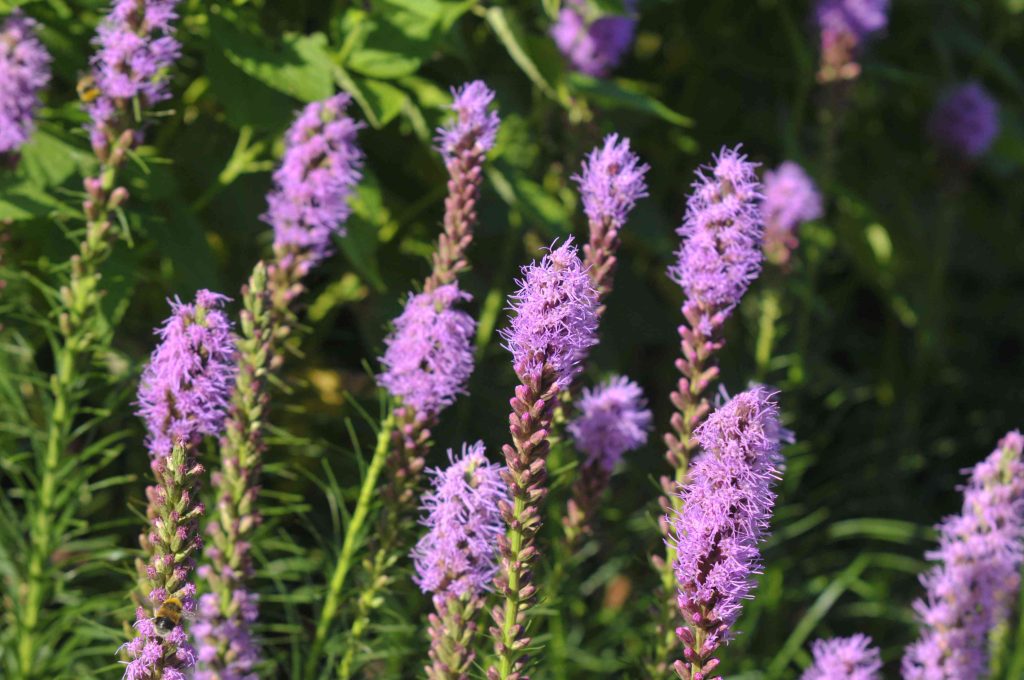
Immerse yourself in the striking beauty of Liatris, a genus of flowering plants commonly known as Blazing Stars or Gayfeathers. These tall, slender plants are renowned for their spiky clusters of vibrant flowers, which attract butterflies and bees to the garden.
Liatris flowers come in shades of purple, pink, or white, depending on the species. The unique spiky flower heads bloom from mid to late summer, creating a vertical element in the garden and providing a valuable food source for pollinators. The long-lasting blooms make Liatris a standout choice for cut flower arrangements.
These plants prefer full sun and well-drained soil. They are drought-tolerant once established and require minimal maintenance. Liatris is ideal for borders, meadows, or naturalistic landscapes, where their tall flower spikes add height and drama to the scenery.
With their striking flowers and ability to attract butterflies and bees, Liatris plants bring a touch of elegance and ecological value to outdoor spaces.
– Common Name: Liatris, Blazing Star, Gayfeather
– Scientific Name: Liatris
– Growing Zones: Varies depending on species
– Sun: Full sun
– Soil: Well-drained soil
– Colors: Purple, pink, white
– Height: Varies depending on species
– Spread: Varies depending on species
– Plant Type: Perennial
